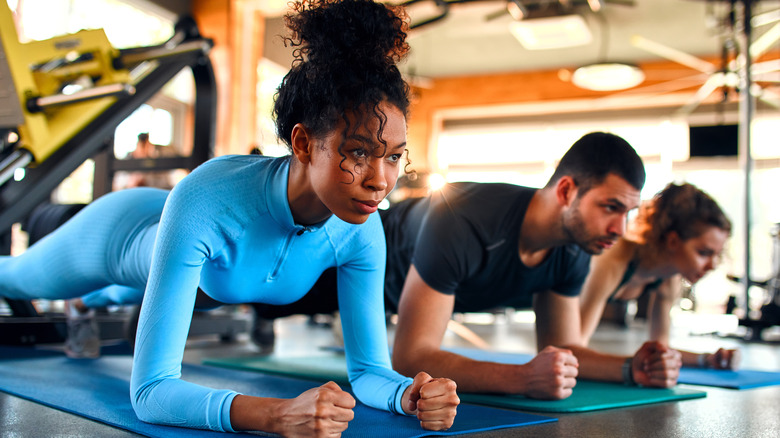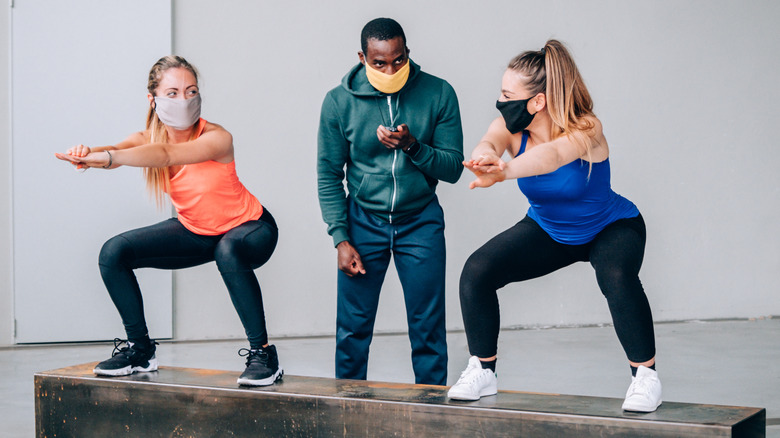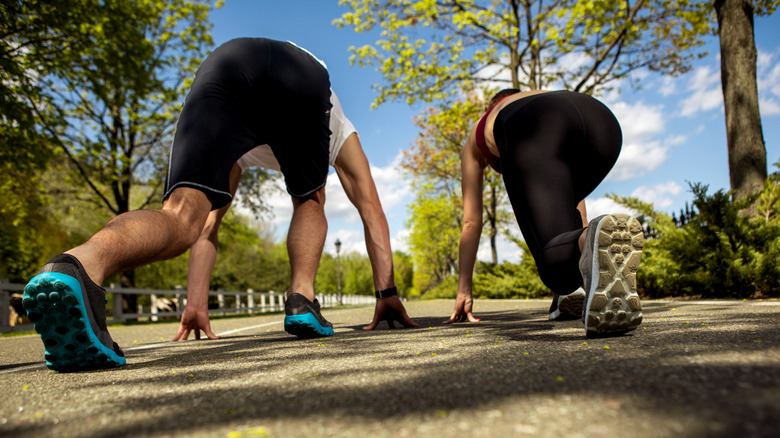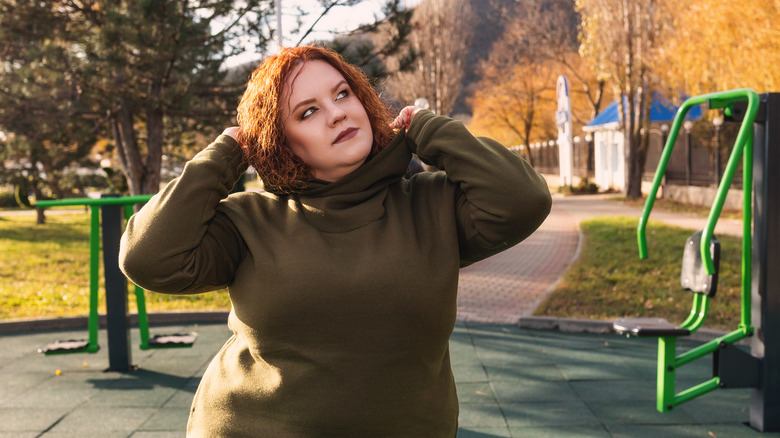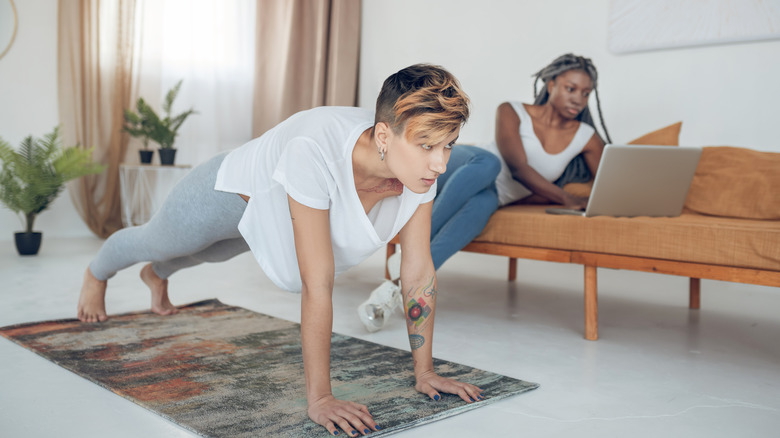How To Sync Your Workout To Your Menstrual Cycle
For those who experience periods, it can sometimes feel like our bodies are against us, and unpredictable hormones make everyday tasks that much harder. Besides cramping, back pain, and potential leakage, menstrual cycles can entail emotional symptoms and even premenstrual dysphoric disorder, a condition often characterized by a decrease in serotonin and a range of severe psychological and physiological symptoms.
However, acute conditions like PMDD may be managed with exercise and other techniques, like giving your body the foods it needs depending on your energy and hormone levels. Even for those whose menstrual cycles involve less intense side effects, tracking your cycle may help you plan your month more efficiently in reaching your goals. Cycle syncing — coined by functional nutritionist Alisa Vitti — includes tracking your menstrual cycles planning your movement patterns, and sometimes the foods you eat around it. The four menstrual phases — menstrual, follicular, ovulatory, and luteal — are each characterized by hormonal and physical changes. Understanding these phases may be the key to anticipating our bodies' ebbs and flows and making the most of these changes.
You might take things slow during your menstrual phase
The first phase of the ovaries' monthly cycle may seem like the main event — for many, it comes with cramps, expensive menstrual products, and feeling like we lack control over our bodies. Though, of course, some of those who menstruate will not notice a major difference in their bodies while they perform everyday tasks or work out on their periods. But subtle hormonal changes may still affect their daily routines since there is a decrease in estrogen and progesterone which may make them feel slower than usual.
For exercise, the consensus is that it's best to keep things light during menstruation if you're feeling discomfort. Hormone specialist and personal trainer Jenn Cino told Byrdie, "I would recommend light activity like slower forms of yoga, stretching, or going for a walk, but if your body is telling you that you need to rest for two days, do it." She explained, "During the second half of your menstrual period, you'll notice your energy levels will start to rise, so if you need to take the first few days of your period off, honor that."
However, this doesn't take more intense exercise off the table for the entirety of our cycle's first phase — in fact, we will likely receive a motivating boost in its latter half. Cino shared, "By days three to five of our period, we will find our energy shifts upwards as our estrogen begins to ascend toward ovulation."
The follicular phase is good for high-intensity
The follicular phase begins at the same time as menstruation but continues up until ovulation, typically around day 14 of a monthly cycle. We start seeing an increase in estrogen and progesterone mid-follicular stage, indicating an increase in our energy levels. Lucky Sekkhon, MD, a fertility specialist and OB-GYN, recommends leaning into these developments. "This is the best moment of opportunity for high-intensity work-outs," she shared with Byrdie. "There's a higher pain tolerance, improved muscle recovery, and you'll reach your peak heart rate more easily. High impact exercise is likely to be most comfortable during this phase, especially as the ovaries will be small, as ovulation (the release of an egg) has not yet taken place from an enlarged follicle/cyst in the ovary."
Dr. Ajai Seth, a consultant in sports and exercise medicine, agreed that it's beneficial to take advantage of this stage. He told Harper's Bazaar, "During your period at the start of your cycle, progesterone and estrogen levels are at their lowest, which can cause low energy and mood fluctuations." He added, "However, during the first 14 days of your cycle (the follicular phase), your body adapts and responds to strength training better than in the later stages of your cycle. It is easier to build and gain strength and muscle mass during this time." And if the follicular phase is for bulking, then the ovulatory phase is for using those muscles to the fullest.
The ovulatory phase is a brief window
During ovulation, the body releases the mature egg to be potentially fertilized sometime within a three to five day period in the middle of our cycles, usually around day 14. This phase comes with a peak in estrogen and testosterone that helps us kick things into high gear, and as Dr. Ajai Seth explained, it just might put us in personal record setting territory. "Many athletes time their performances and are exertional training for this time to maximize their results," he shared with Harper's Bazaar, so it might also be the perfect time to finally check out that intimidating HIIT or kickboxing class.
Ovulation has been linked to an increase in confidence, as well as self-perceived attractiveness. However, some of those who menstruate may experience symptoms like bloating, abdominal pain, and sore breast tissue, which might become factors in whether or not they will enjoy high-intensity exercise. Dr. Jenn Sino also warned Byrdie readers, "Be mindful of plyometrics or anything that puts excess pressure and impact on your knees, though, because women are at a greater risk of having an ACL injury during the ovulatory phase."
The luteal phase has been thoroughly studied
The luteal phase encompasses the last two weeks of the menstrual cycle and has been linked to a potential steady decrease in athletic performance. One study on the impact of the mid-luteal phase on runners found that its association with increased body temperature and breathing rate is one of the factors that can inhibit athletic performance or running economy. Another study made a connection between the phase and higher body heat paired with rising cardiovascular strain, noting that athletes who menstruate may want to plan around environmental factors, like hot weather and humidity, which might exacerbate these issues. Finally, a 2017 study found a decrease in endurance in soccer players in the mid-luteal stage.
Though understanding that changing levels of estrogen and progesterone can indeed have neurological and physiological effects, it's important to understand that generalizations based on hormones and behaviors — such as complaints of PMS or premenstrual syndrome in those who menstruate — rarely amount to more than just generalizations. In fact, A 2010 study found that participants with stronger menstrual symptoms actually experienced greater mid-cycle contentedness than their counterparts with less severe symptoms. The first group's average levels of anxiety and depression were also lower than those who experienced fewer menstrual symptoms throughout their cycles, which seems to indicate that symptoms of PMS don't necessarily result in increased neurological distress (despite popular misogynistic depictions in the media).
Listen to your own body's signals
Dr. Ajai Seth asserted that there is a beneficial relationship between hormonal changes and exercises and that one may facilitate or positively affect the other. He told Harper's Bazaar, "Hormonal fluctuations during the cycle can positively influence your energy levels and performance." He added, "The endorphin and serotonin release during and after exercise has an antidepressant and mood-elevating effect, helping us through menstrual symptoms. These hormones can also alleviate pain such as cramping and bloating by aiding digestion."
So, our hormones may aid us in exercise, and exercising may help our bodies deal with the symptoms of hormonal fluctuations, potentially throughout our cycles, per Kayla Itsines, a personal trainer. Still, she said we should always listen to our bodies when exercising. Reflecting on her experience with endometriosis, she wrote, "You don't just need to put up with pain, and you definitely shouldn't put pressure on yourself to train if you feel unwell during your period." She added, "Check in with your doctor, family, or friends if something doesn't feel right, remember no one knows your body better than you do."
It may not feel great to put ourselves through intense workouts just because we've heard that exercise is vaguely good for you during your period. But now we know that strategic movement can help manage our menstrual symptoms and that we may even have our cycles to thank for some of our best days in the game.
